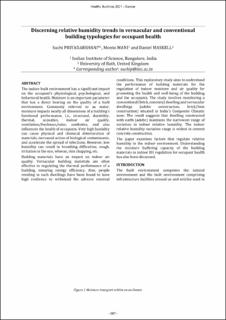| dc.description.abstract | The indoor built environment has a significant impact on the occupant's physiological, psychological, and behavioral health. Moisture is an important parameter that has a direct bearing on the quality of a built environment. Commonly referred to as water, moisture impacts nearly all dimensions of a building's functional performance, i.e., structural, durability, thermal, acoustics, indoor air quality, ventilation/freshness/odor, aesthetics, and also influences the health of occupants. Very high humidity can cause physical and chemical deterioration of materials, increased action of biological contaminants, and accelerate the spread of infections. However, low humidity can result in breathing difficulties, cough, irritation in the eye, wheeze, skin chapping, etc. Building materials have an impact on indoor air quality. Vernacular building materials are often effective in regulating the thermal performance of a building, ensuring energy efficiency. Also, people residing in such dwellings have been found to have high resilience to withstand the adverse external conditions. This exploratory study aims to understand the performance of building materials for the regulation of indoor moisture and air quality for promoting the health and well-being of the building and the occupants. The study involves monitoring a conventional (brick, concrete) dwelling and vernacular dwellings (adobe construction, brick/lime construction) situated in India's Composite Climatic zone. The result suggests that dwelling constructed with earth (adobe) maintains the narrowest range of variation in indoor relative humidity. The indoor relative humidity variation range is widest in cement concrete construction. The paper examines factors that regulate relative humidity in the indoor environment. Understanding the moisture buffering capacity of the building materials in indoor RH regulation for occupant health has also been discussed. | |

